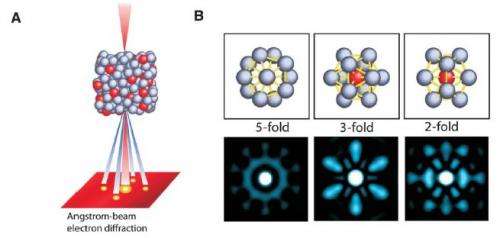(A) Experimental procedure of Angstrom-beam electron diffraction of a icosahedral cluster. The coherent electron beam has a diameter of 0.36 nm. (B) Simulated ABED patterns of an ideal icosahedron. Credit: (c) Science DOI: 10.1126/science.1232450
(Phys.org) —Metallic glasses are essentially a frozen, supercooled liquid. They are amorphous metals, often alloys, which are non-crystalline and therefore have a highly disordered atomic arrangement. They are true glasses in the sense that they soften and flow upon heating. The ability to easily process these materials has led to their use in many products, like for example, those made by injection molding. Over a half century ago, it was proposed that metallic liquids, and perhaps even glasses possess icosohedral clusters. Despite attempts using neutron or x-ray scattering to reveal this icosohedral order, only average structural information has been obtained. A new paper published in Science, describes development of an Angstrom-beam electron diffraction (ABED) method which is able to probe local atomic structure with a 0.4 nm electron beam. The authors were able to characterize local icosohedral order in ZrPt (Zr80-Pt20)glass, and found that it is in close agreement with that predicted by computational simulations.
The researchers determined that a distorted icosahedron with partical fcc (face-centered-cubic) symmetry is representative of the local structure of the Zr-Pt glass. They further conducted a bond orientational order analysis based on a molecular dynamics simulation containing 12000 atoms to confirm this observation. This distortion of the icosahedra had been suggested by bond length variation resulting from a combination of atomic size disparities and kinetic fluctuations occurring during glass formation.
The finding that the distorted icosahedral always possessed fcc symmetry derives from a phenomenon known as "geometric frustration." The origin of the frustration comes from competition between the low energy icosohedral or fcc states, and dense atomic packing. The concept of geometric frustration in metalic glasses derives from certain features of magnetism, where it is associated with the topological arrangement of spins. It also has been applied to ice formation.
The stability of solids, something that we take for granted, is still a primary topic of study in condensed matter physics. In geometric frustration, certain types of local order, favored by physical interactions, are prevented from propagating through space. A classic example is that of pentagonal, or icosahedral, order which appears in the simple three-dimensional sphere packing problem. This kind of symmetry is not compatible with translation in space, and presents a contradiction between local and global optimal configurations.
The authors note that this atomic packing scheme, where low symmetry is found despite dense atomic arrangement has not been found in any quasicrystal or crystal, and is therefore a unique feature of metallic glasses. They suggest that the ABED method will also be of use in exploring the atomic structure and properties of other kinds of disordered materials.
More information: Geometric Frustration of Icosahedron in Metallic Glasses, Science DOI: 10.1126/science.1232450
ABSTRACT
Icosahedral order has been suggested as the prevalent atomic motif of supercooled liquids and metallic glasses for over a half century because the icosahedron is highly close packing but difficult to grow owing to structure frustration and the lack of translational periodicity. By means of angstrom-beam electron diffraction of single icosahedra, we report experimental observation of local icosahedral order in metallic glasses. All the detected icosahedra were found to be distorted with partially face centered cubic symmetry, presenting compelling evidence on geometric frustration of local icosahedral order in metallic glasses.
Journal information: Science
© 2013 Phys.org


.jpg)




















